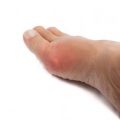A dead skin refers to the dead skin cells that our bodies are always shedding and replacing with new cells. Our bodies shed between 30,000 and 40,000 skin cells per day. Normal cell turnover takes place about every 30 days.
This process of desquamation on the feet includes new skin cells being produced and sloughing away dead skin cells. Sometimes, however, dead skin cells don’t shed off normally. When this happens, they can build up and make the skin on the feet appear as dull, flaky.
The skin on your feet probably takes more strain than you realize. From the irritation of tight or stuffy shoes to direct contact with contaminated surfaces to overexposure to the elements.
What causes dead skin on the feet?
Several factors can influence the death of skin cells on the feet, including:
Aging: Aging is one of the most common reasons for dead skin cells to pile up on the feet. As you age, your skin cells lose the capacity to regenerate as quickly, leading to the accumulation of dead skin cells on the surface.
Dry Skin: A lack of moisture in the skin cells can increase the rate of cell death, leading to an increased production of dead skin cells on the surface of the feet. Skin dryness may result from medical problems, dehydration, not moisturizing, etc.
Not exfoliating the skin: Exfoliation is an important step of any skin care routine. Not exfoliating the skin at least twice a week allows the dead skin cells to remain on the skin surface. Moreover, irregular exfoliation can cause clogging of the skin pores with oil, dirt, and makeup residue, which hinders the shedding of old skin cells and the production of new ones.
Environmental factors: Since the skin on the feet is regularly exposed to the environment, it can largely influence skin health. Dry skin is common in arid, cold, and dry climates. A lack of humidity in the atmosphere can dry up the skin and trap the dead skin cells.
Exposure to Sun: Excessive exposure to sunlight can cause skin dryness, leading to the formation of dead skin cells.
Underlying skin conditions: A severe problem of dead skin cell accumulation can be a symptom of different skin conditions that warrant medical attention, including eczema and psoriasis.
Signs and Symptoms of Dead Skin Cell Accumulation
Dry and dead skin may be associated with the following symptoms:
- Small scales
- Fine lines
- Flakiness
- Deep cracks
- Dry patches
- Premature signs of aging.
How To Get Rid Of Dead Skin On Feet
Dead skin on the bottom of your foot may appear dry, cracked, or loose or hanging. It’s usually not painful unless it’s a result of athlete’s foot, eczema, or another type of infection.
If you suspect that’s the case, see your doctor for treatment. Otherwise, you may want to remove dead skin for cosmetic reasons or because it’s more comfortable.
Here are some options for removing dead skin:
Pumice stone: A pumice stone is a natural lava stone that can help remove dead skin and callouses from your feet. A pumice stone can be used to remove the dead skin from a callus or corn. Reducing the size of the callus or corn may result in less pressure or friction and less pain. Soak your foot or other affected area in warm, soapy water for 5 minutes or until the skin softens. Gently move the stone in a circular or sideways motion around your foot to remove dead skin and apply lotion or oil afterward to help soften your feet.
Paraffin wax: Paraffin wax is a white or colorless soft, solid wax. It’s made from saturated hydrocarbons. It’s often used in skin-softening salon and spa treatments on the hands, cuticles, and feet because it’s colorless, tasteless, and odorless. During a paraffin wax treatment, you’ll dip your feet in the wax several times. After several layers of wax are applied, wrap your feet in plastic. After the wax hardens, you can remove the wax. Any dead skin on your feet will be removed along with the wax. Your feet should feel soft afterward.
Foot scrub: Most pharmacies and drug stores sell different foot scrubs over the counter. Look for one with granules that will help scrub away dead skin. Massaging your feet with a scrub boosts blood circulation, which helps relieve aches. Massaging your feet relaxes your mind and body, thus relieving stress. It makes your feet look amazing because the foot scrub gently exfoliates and removes all the dirt and dead skin cells.
Oatmeal scrub: Oatmeal has antioxidant and anti-inflammatory properties that helps to treat dry skin and remove dead skin cells. Oats also contain compounds called saponins, which are natural cleansers. They remove the dirt and oil that clog the pores and exfoliate the skin.
Epsom salt soak or scrub: Epsom salt is a crystal form of magnesium sulfate. Magnesium sulfate is a mineral compound. You can soak your feet in Epsom salt that’s dissolved in water. It can help exfoliate and smooth dry, cracked feet. This, in turn, may help remove dead skin.
Vinegar soak: Vinegar soaks may help soften feet and allow you to remove dead, dry, or cracked skin. You can use almost any type of vinegar. Apple cider vinegar or white vinegar are popular options, and you may already have them in your kitchen.
Baking soda soak: Baking soda is a popular at-home treatment for the removal of dead skin from the feet. But some dermatologists warn that baking soda can be irritating, cause redness, and dry out the skin further. That’s because it may disrupt the skin’s natural pH balance.
If you have any skin sensitivities or allergies, don’t use baking soda on your feet. Always check with your doctor or podiatrist before trying out a new treatment.
If you decide to use baking soda, only use a small amount (2-3 tablespoons) in a full footbath of warm water for 10-20 minutes.
After your soak, gently use a pumice stone or foot brush using the method mentioned above to remove dead skin. Apply plenty of moisturizer after.
If you experience any redness or irritation while soaking your feet, immediately remove them from the solution. ALSO READ: How to Repair Damaged Skin






